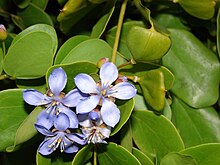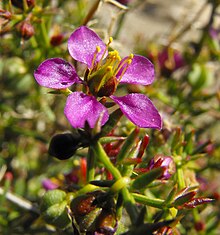Yoke-leaf plants
| Yoke-leaf plants | ||||||||||||
|---|---|---|---|---|---|---|---|---|---|---|---|---|

Guaiac tree ( Guajacum officinale ), illustration |
||||||||||||
| Systematics | ||||||||||||
|
||||||||||||
| Scientific name | ||||||||||||
| Zygophyllaceae | ||||||||||||
| R.Br. |
Jochblattgewächse (Zygophyllaceae) are a family in the order of the zygophyllales within the flowering plants (Magnoliopsida).
description
Vegetative characteristics
They are mostly trees , shrubs or half-shrubs , rarely annual or perennial herbaceous plants . Some species are xerophytes . The nodes are often thickened. The leaves, which are rarely alternate or mostly opposite, are usually stalked, simple or (usually in pairs) pinnate, often they are fleshy. The stipules are often preserved for a long time and they are often transformed into thorns.
Generative characteristics
The racemose or zymous inflorescences are solitary, terminal or axillary. The mostly hermaphrodite flowers are fivefold, sometimes fourfold; they are radial symmetry or rarely zygomorphic . Only the Neoluederitzia are dioeciously separated sexes ( diocesan ). They have free or at most fused at their base petals and sepals . There are one to two circles with four to five free stamens , most of which have scales at their base. Rarely two or three, usually four to five carpels have become a top permanent ovary grown. In each ovary chamber there are one to several hanging ovules . Usually there is only a thin stylus that ends in a cephalic to slightly four to five-lobed scar.
They usually form capsule fruits , rarely stone fruits ( balanites ) or split fruits . The seeds contain a straight to slightly curved embryo containing chlorophyll.









Systematics and distribution
The Zygophyllaceae are a variable group that thrives in more or less arid and saline ( halophilic ) areas in many parts of the world. Most species have a tropical or subtropical distribution, but they are also rarely found in warm temperate areas.
The family was first published in 1814 by Robert Brown under the name "Zygophylleae" in A Voyage to Terra Australis , 2, p. 545. Type genus is Zygophyllum L. Synonyms are for Zygophyllaceae R.Br. are Balanitaceae M.Roem. and Tribulaceae Trautv. Since the overview work by Engler in 1931 and Scholz in 1964 on Zygophyllaceae, it has been divided into seven subfamilies and a number of tribes and subtribes. This remained essentially unchanged for a long time until two of the subfamilies to the Sapindales are now in the family of the Nitrariaceae ( Peganum , Malacocarpus , Tetradiclis and Nitraria ) by Gadek et al. 1996 and Sheahan & Chase 1996 were spun off. The genus Krameria L. forms its own family Krameriaceae Dum. The two families Zygophyllaceae and Krameriaceae are the only families of the order Zygophyllales (as early as APG 1998).
The yoke leaf family (Zygophyllaceae) is now divided into five subfamilies, with 25 to 27 genera and around 240 to 285 species :
- Subfamily Larreoideae Sheahan & Chase : The five to seven genera and about 30 species are widespread in the Neotropics from the southwestern USA via Mexico to South America:
-
Bulnesia Gay (including Gonoptera Turcz. ): The eight or so species thrive in dry areas of South America, for example in the Gran Chaco (Argentina), including:
- Bulnesia arborea (Jacq.) Engl.
- Bulnesia retama (Gillies ex Hook. & Arn.) Griseb.
-
Guajak ( Guaiacum L. , orth. Cons .; Guajacum L. orth. Var.): The six to eight species are common in tropical and warmer areas of the New World, for example:
- Guaiac tree ( Guaiacum officinale L. )
-
Larrea Cav. (Including Covillea M.Vail , Neoschroetera Briq. , Schroeterella Briq. ): The approximately five species are distributed in Peru and Argentina and one species thrives in the dry deserts of the USA, for example in the Mohave :
- Creosote bush ( Larrea tridentata (DC.) Coville )
- Larrea ameghinoi Speg.
- Larrea cuneifolia Cav. : It is widespread in Argentina.
- Larrea divaricata Cav. : It occurs in Bolivia, Peru, Argentina and Chile.
- Larrea nitida Cav.
-
Metharme Phil. Ex Engl .: It contains only one species:
- Metharme lanata Phil . : It is endemic to Tarapacá in Chile.
-
Pintoa Gay : It contains only one species:
- Pintoa chilensis Gay : It only thrives in the Atacama Desert .
- Plectrocarpa Gillies ex Hook. & Arn. : with two to three species in northwestern Argentina.
- Porlieria Ruiz & Pav .: With five species in South America and one from northern Mexico to Texas .
-
Bulnesia Gay (including Gonoptera Turcz. ): The eight or so species thrive in dry areas of South America, for example in the Gran Chaco (Argentina), including:
- Subfamily Morkillioideae Rose & JHPainter : with three genera and four species in Mexico and Baja California (Baja California):
- Morkillia Rose & JHPainter (including Chitonia Moç. & Sessé ): with only two species in Mexico.
-
Sericodes A.Gray : It contains only one species:
- Sericodes greggii A.Gray : It occurs in northern Mexico.
-
Viscainoa Greene : It contains only one species:
- Viscainoa geniculata Greene : It grows in Mexico mainly in Baja California.
- Subfamily Seetzenioideae MCSheahan & MWChase : only one monotypic genus:
-
Seetzenia R.Br. ex Decne. : It contains only one type (sometimes two types):
- Seetzenia lanata (Willd.) Bullock : It has a disjoint area in the southern Capensis and from northern Africa to Afghanistan .
-
Seetzenia R.Br. ex Decne. : It contains only one type (sometimes two types):
- Subfamily Tribuloideae DHPorter : worldwide with about six genera and about 63 species:
-
Balanites Delile : with about nine species in Africa and Asia; for example:
- Desert date ( Balanites aegyptiaca (L.) Delile )
- Kallstroemia Scop. (including Ehrenbergia Mart. ): with about 17 species in the Neotropic.
- Kelleronia Schinz : with up to 10 species in Somalia
-
Neoluederitzia Schinz : It contains only one species:
- Neoluederitzia sericeocarpa Schinz : It only thrives in swamps in Namibia .
-
Sisyndite E. Mey . ex Sond. : It contains only one type:
- Sisyndite spartea E. Mey . ex Sond. : It occurs in the Capensis.
- Tribulopis R.Br. (Syn .: Tribulopsis R.Br. orth. Var.): With six to ten species in Australia .
- Root thorns ( Tribulus L. ): with about 15 to 25 species in Eurasia , Africa and Australia. They are the only genus of the family to have ovaries with false partitions, the spread is epizoochoric through prickly capsule fruits.
-
Balanites Delile : with about nine species in Africa and Asia; for example:
- Subfamily Zygophylloideae: They mostly thrive in arid areas in the Old World , but also in the southwestern United States and Chile. With four to six genera and about 137 species:
-
Augea Thunb. : It contains only one type:
- Augea capensis Thunb. : It thrives in the southwestern Capensis.
- Fagonia L .: with about 34 (up to 45) species in the Mediterranean region and southwest Asia to India, in southwest Africa and in southwest North America
- Melocarpum (Engl.) Beier & Thulin : with only two species in the Capensis.
- Roepera A.Juss. : About 61 species, although some authors also with up Zygophyllum made
-
Tetraena Maxim. : It contains only one type:
- Tetraena mongolica Maxim. : It is endemic to Inner Mongolia .
-
Yoke leaf ( Zygophyllum L .; including Halimiphyllum (Engl.) Boriss. , Miltianthus Bunge , Sarcozygium Bunge ): with about 36 to 120 species, for example:
- Zygophyllum album L. f.
- Bean-like yoke leaf ( Zygophyllum fabago L. ).
-
Augea Thunb. : It contains only one type:
use
The guaiac tree ( Guaiacum officinale ) supplies the wood called "Lignum vitae" with extremely high density and hardness. Some species of Guaiacum , Zygophyllum , Tribulus and Larrea are used as ornamental plants in warm areas .
The flower buds of Larrea tridentata are inserted as a substitute for capers; A tea is brewed from the bark and leaves. The medicinal effects of this species have been studied.
The leaves and young shoots of Tribulus terrestris are eaten cooked. The fruits are eaten cooked or flour is made from them. The medicinal effects of this species have been studied.
From Bulnesia retama is retamo ( Ceramimbiwachs ) won.
swell
- The family of zygophyllaceae in APWebsite. (Section description, distribution and systematics)
- The Zygophyllaceae family at DELTA by L. Watson & MJ Dallwitz. (Section description)
- Yingxin Liu, Lihua Zhou: Zygophyllaceae. In: Wu Zheng-yi, Peter H. Raven, Deyuan Hong (Eds.): Flora of China . Volume 11: Oxalidaceae through Aceraceae . Science Press / Missouri Botanical Garden Press, Beijing / St. Louis 2008, ISBN 978-1-930723-73-3 , pp. 45 (English). , online (description and identification key of the Chinese taxa).
- Abdul Ghafoor: Flora of West Pakistan 76: Zygophyllaceae . Stewart Herbarium, Gordon College (et al.), Rawalpindi 1974, p. 1-35 (English, online ). (Section description).
- Mary C. Sheahan, Mark W. Chase: Phylogenetic Relationships within Zygophyllaceae Based on DNA Sequences of three Plastid Regions, with Special Emphasis on Zygophylloideae. In: Systematic Botany. Volume 25, No. 2, 2000, pp. 371-384, doi : 10.2307 / 2666648 (section systematics and description).
Individual evidence
- ^ A b Zygophyllaceae in the Germplasm Resources Information Network (GRIN), USDA , ARS , National Genetic Resources Program. National Germplasm Resources Laboratory, Beltsville, Maryland.
- ^ A b Larrea in the Germplasm Resources Information Network (GRIN), USDA , ARS , National Genetic Resources Program. National Germplasm Resources Laboratory, Beltsville, Maryland. Retrieved March 3, 2017.
- ^ Larrea tridentata at Plants For A Future
- ^ Tribulus terrestris at Plants For A Future
- ^ Heinz A. Hoppe: Drug Science. Volume 1 Angiosperms , 8th edition, De Gruyter, 1975, ISBN 3-11-003849-8 , p. 189.